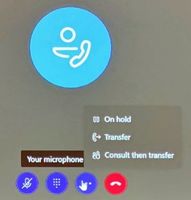This post has been republished via RSS; it originally appeared at: Microsoft Teams Events Blog articles.
There is a phenomenal interest in Teams from organizations of all sizes: almost every session I visited was packed to the roof, and it was no different for this session; not in the least because it brought together two very hot topics: Teams and Voice communications!
There is no doubt that Microsoft is committed to bringing Voice as a first-class citizen to Teams --in the same way they did for Skype for Business. After all, one does not get to be name a leader in Gartner's Magic Quadrant if that were not true.
All statistics aside, the most impressive part of this session was not the numbers of the fact that Microsoft is committed to bringing Voice to Teams. Instead, it was what was shown. The single client - used across various devices and platforms - provide users with a familiar and easy interface enabling them to communicate in the same way, regardless of their location or what device they are using --whether it be a laptop, desk phone or smart phone. Especially the mobile aspect of communications is important. Today, no less than 62% of all meetings is connect to using a mobile device and expectations are that approximately 72% of all workers will be working remotely by 2020. That is huge!
As the adoption of Teams grows, so does the offering of devices that (natively) support Teams. To help you navigate the ecosystem, Microsoft has spun up a website where you can discover these (new) devices: from personal devices to shared devices like meeting room systems: Office.com/teamsdevices
At the core of Microsoft's Voice capabilities, there are various options: Phone System, Calling Plans and Direct Routing or a combination thereof allowing you to cover most scenarios and replace your (legacy) PBX with Office 365.
Throughout the various demos, Paul and Anna showed that Teams is more than capable of supporting most of the common communication scenarios organization face in an easy and non-disruptive way. For instance, you can simply initiate a call from Teams using the "/call" command, or perform a "consultative transfer" via either IM or a quick call:
Obviously, a blog post isn't the best way to describe or recreate the experience of the demos. I strongly suggest you re-watch the session and see what it's all about? But here's the TL;DR-version of things:
- The calling app in Teams will shortly be enabled by default. It's a great way to make users familiar with the capability (show that it exists ahead of deploying Voice).
- Users will be able to define "priority access" (DND Breakthrough). It's very similar to defining favourites on an iPhone. Users in that list will still be able to get through to you --even when your status is set to "Do Not Disturb"
- Today, the voice features for Teams are still managed through the old Skype for Business Online admin center, but that will change by the end of this year as the administration efforts will all be consolidated into the new admin portal.
- You can configure distinctive ringtones for different type of calls (e.g. direct calls to you, forwarded calls or delegated calls)
- Support for Call Queues and Auto Attendants, plus the super-easy configuration thereof, make it a great way to setup call menus. One example I could immediately think of is using a single phone number for a support desk or specific department in your organization.
Mind you, these are just the highlights. There is plenty more, and there is plenty more coming in the future too:
- Call Park,
- Shared Line Appearance,
- Group Call Pickup
- Share your screen, directly from chat
- VoIP for everyone (enabling the calling app by default)
- ...
Again: there is no way that a short recap of this session (in writing) can do any of the features and demos justice. Voice is here and Teams is ready for it. I encourage you to watch the session and experience how calling in Teams (across various devices, such as the demoed YeaLink desk phone) can support various scenarios in an easy and intuitive way. The latter is something I was really impressed with!
Recording: https://myignite.techcommunity.microsoft.com/sessions/65551?source=sessions#ignite-html-anchor




